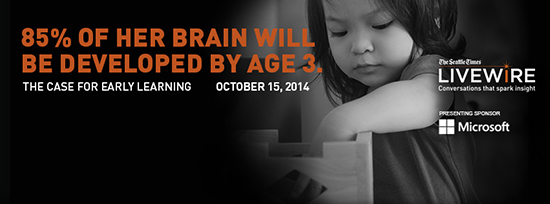How do children learn from birth to age 3? Our experts weigh in on what science shows in brain development, what parents and caregivers can do to help young children be school ready, and characteristics of quality early learning programs.
 Patricia Kuhl and Andrew Meltzoff, co-directors of the University of Washington's Institute for Learning & Brain Sciences, will give a presentation "Brain Science and Early Learning" at a Oct. 15 event organized by the Seattle Times. The public event includes a discussion on "The Case for Early Learning" with a panel of educators and political leaders.
Patricia Kuhl and Andrew Meltzoff, co-directors of the University of Washington's Institute for Learning & Brain Sciences, will give a presentation "Brain Science and Early Learning" at a Oct. 15 event organized by the Seattle Times. The public event includes a discussion on "The Case for Early Learning" with a panel of educators and political leaders.
Here Kuhl and Meltzoff give a sneak peek of the science of brain development and early learning:
Q. The LiveWire website says that 85 percent of children's brains will be developed by age 3. Why is this significant for early learning?
A. This statistic supports the idea that the first 3 years of an infant’s life are critical. Teenagers undergo rapid change, including a visible change in height and body shape. These are apparent to the naked eye. Less visible but equally or more important is the transformation happening inside your baby’s brain in the first 3 years. Your baby is undergoing astounding mental remodeling during this time. It’s key, but invisible. The statistic jolts people into realizing that there’s a lot going on up there, visible or not. Understanding brain development is important to both science and practice.
Q. What are some of the best things parents and caregivers can do during a child's first five years of life to help him or her be ready to enter school?
A. Parents and caregivers have a great deal of influence on children’s early lives. The most important thing they provide is social-emotional support that allows children to thrive and exercise their creativity. Research has shown that early supportive relationships set the stage for learning. As children grow to trust their loved ones, they feel more secure and empowered to explore the world around them. Over time, children increasingly look to parents and caregivers to guide their learning. They look for information about whether a new behavior is acceptable or for guidance on how to use a new tool. By being responsive to babies’ needs, modeling desirable behaviors, and helping children through new experiences, parents and caregivers provide the support necessary for a lifetime of learning. Importantly this sets the foundation for kids being creative and feeling safe to take on new challenges so they can grow and expand their interests and skills.
Q. What are some of the characteristics of quality early learning programs?
A. All quality early learning programs combine presence of attentive and engaged teachers and staff with a stimulating, playful environment. Research has shown that teachers’ support for language and conceptual knowledge enhances early language skills, and numeracy readying children for the transition to school. Small teacher-to-student ratios are also important as they increase one-on-one interactions in which teachers can guide children’s play. Child-directed play, art, music, and dramatic play are all activities that foster a child’s developing brain and that will be hallmarks of quality early learning programs. Basically, good early learning programs foster curiosity, which is the fuel that drives all future learning.
Q. If people want some more background on early learning, where should they go?
A. I-LABS is dedicating itself to doing forefront science and getting useful information out the door and into the hands of people who can use it. We have created a series of online information modules that explain the science of early learning and show how it can be used in daily interactions with children. These tools are free and accessible through our website. As we made them we kept in mind the needs and interests of early childhood educators, parents, grandparents, and other caregivers. Anyone with an interest in this topic should check them out. We think they’re both fun and informative and the short movie clips are great! For the LiveWire event, modules "Why the First 2000 Days Matter" and the "The Importance of Early Interactions" may be the most relevant. But all of the modules provide useful information on early learning and brain development – they have visuals and videos and give real-life examples of how to put the science to work.
The other panelists at the Oct. 15 event are Ruth Kagi, Washington State representative; Seattle Mayor Ed Murray; Ron Peters, former Oklahoma state legislator; and Anne Arnold, director of the Highline School District. John Higgins, K-12 education reporter for the Seattle Times, will be the moderator.
It is the inaugural event in the Seattle Times' LiveWire series, which is intended to "feature meaningful discussions about vital issues impacting our region and its people." Learn more about the event – to be held on Microsoft's campus in Redmond, Wash. – and the other panelists online. More about the LiveWire series is described in a Seattle Times news release.
What are your questions about early learning and brain science? Ask our Outreach team: [email protected].
###